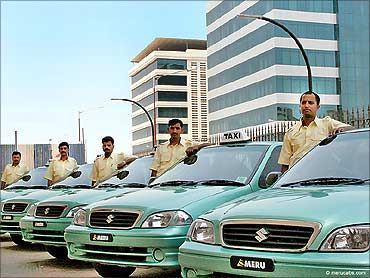 | « Back to article | Print this article |
Technology exists to match supply and demand for metered taxis and auto-rickshaws but the regulator has been slow to devise and impose a solution, feels Subir Roy
 Most Indian cities, not to speak of smaller urban clusters, do not have auto-rickshaws, not to speak of taxis, that always run on meters (Mumbai is the great exception) and can be easily hailed at street kerbs.
Most Indian cities, not to speak of smaller urban clusters, do not have auto-rickshaws, not to speak of taxis, that always run on meters (Mumbai is the great exception) and can be easily hailed at street kerbs.
In the few that do, drivers try to negotiate a fare and avoid going by the meter, which is often rigged.
Kolkata has long relied on its yellow metered taxis to do the job, but the system is threatening to come apart.
To address a crescendo of complaints, the state government recently created a new category of taxis that have a self-explanatory ‘no refusal’ blazoned on them and come in the by-now-ubiquitous blue and white colours of the Trinamool Congress.
But these have turned out to be a joke, as they also ‘refuse’ quite often.
In response, the police started fining errant taxi drivers; and after a few days of this, the taxi drivers went on one-day strikes and threatened more.
So things are back to square one.
You can be sure there will be similar revolts if you tried, say, getting Delhi’s and Chennai’s auto-rickshaw drivers to always go by a correct meter and not decline customers.
The drivers also have a point.
They are hard-working poor people who don’t make a bomb even when they pick and choose.
There are times when a driver has to wait unconscionably long for a fare and sometimes has to return empty a good part of the way back from a far off suburban trip.
Things get worse as the evening progresses -- auto or taxi drivers’ demands get exorbitant and customers feel totally helpless.
This is a clear case of mismatch between supply and demand at a particular time and place where someone needs to make a trip -- although probably, in total, there are enough carriers and customers to make everyone happy.
What is amazing is that technology exists to match supply and demand, but the regulator who has to impose a solution (only general acceptance can create the necessary volumes) is slow to devise one and adopt it.
What technology can do has been highlighted by the gradual introduction of Uber services in successive Indian cities.
Right now, it charges taxi drivers a hefty commission, you need a credit card to use the service -- and, considering that their taxis are large air-conditioned sedans, the rates are quite likely to go up once the introductory period is over.
It is not a service for the aam admi.
But an officially blessed (not run) similar system can be a boon.
All that is needed is for taxi and auto-rickshaw drivers to own smartphones (their prices are crashing and nudging Rs 5,000) and download an application (app) on it, and a modest call centre.
This is how the system can work.
If you need a taxi (the same system will work for auto-rickshaws) in Delhi to go from, say, Punjabi Bagh to Jangpura, you SMS your destination address or simply ‘Taxi Jangpura’ to the call centre number.
The centre will simultaneously know your location, courtesy the nearest tower your SMS used, and, of course, all the taxis in the area that have logged in to be ready to ply.
It will transmit the phone number of the customer to a handful of taxis in the area.
The one that reaches the customer first and finalises the trip and pickup point sends a confirmation to the call centre, which informs the other taxis in the area that this fare is taken.
As the taxi, whose trip is tracked by the app, reaches the destination, the call centre knows precisely how much fare is payable and charges the taxi driver’s account with its commission.
The taxi driver in Jangpura will get a chance to take a customer there who wants to go to, say, Mayur Vihar. Near the end of his day, the taxi driver can SMS the centre ‘Rohini’, where he lives, and wait for a passenger wanting to go to Rohini.
The big gain will come after the system has worked for a few months and the server of the call centre has stored enough data to analyse and find a pattern of demand that is location- and time-specific.
The centre can then pass out a message like “Tomorrow 10 taxis needed in Safdarjung at 6 a m, 20 at 7 a m, etc”. The window can close after the first 10 have logged in.
The centre can be run by an information technology contractor engaged by the taxi owners’ or drivers’ association.
My layman’s rough framework has to be debugged and improved upon by professionals, but the basics are indisputably there, courtesy technology, and the solution is so beneficial to all -- a non-zero-sum game.
So why is a local or state government not giving it a push?
Image: Meru Cabs. Photographs: Courtesy, Meru.